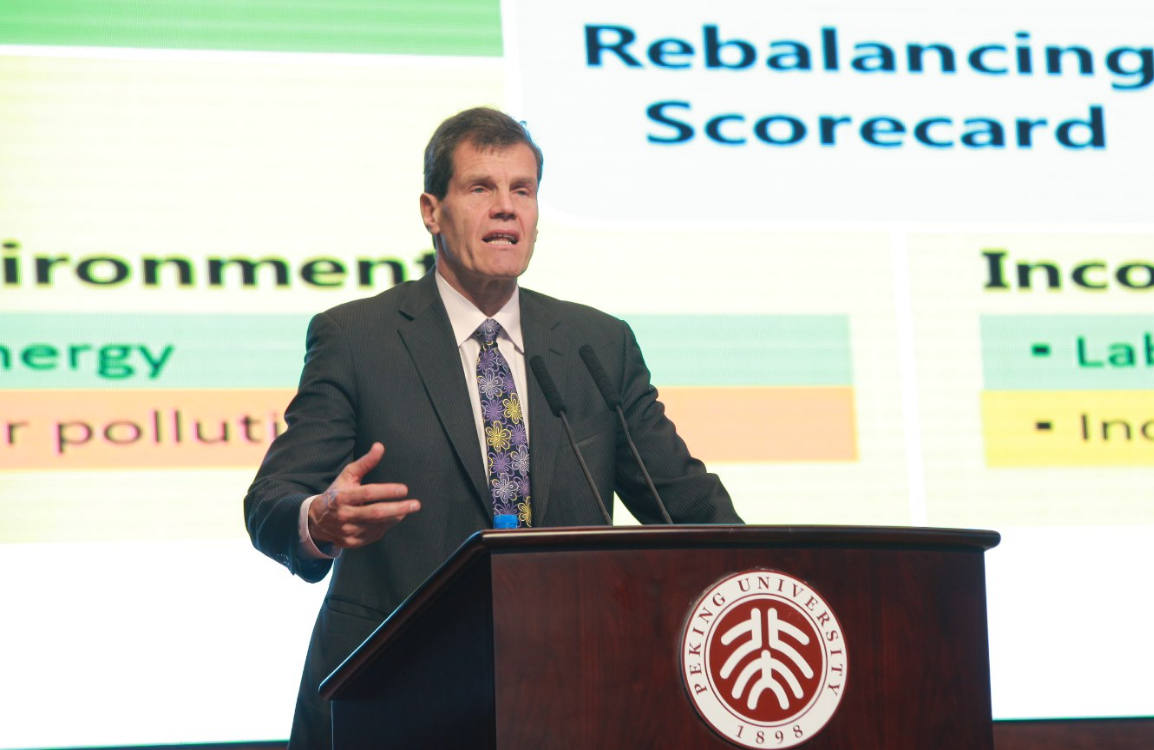By Annie Jin, PHBS Media and Public Relations Office
Edited by Priscilla Young
From Brexit to Trump’s triumph, anxiety about the global economy has been mounting. Market data show that an enormous portion of the world map is now draped in uncertainty, seemingly impervious to prediction by investors, policymakers and scholars. Yet, the greatest threat to the global economy is not Brexit, but an impending crash in China, according to Harvard professor Ken Rogoff, one of the world’s most eminent economists. Though previously seen as the world’s driving force, China is now slowing significantly, facing significant problems like shadow banking, high corporate and financial debt, and economic transition. The International Monetary Fund’s (IMF) latest world economic outlook revealed that debt in China was rising at a "dangerous pace," while its financial stability report showed small Chinese banks were heavily exposed to shadow credit as a share of capital buffers.
The silver lining is that the IMF included Chinese renminbi (RMB) in the Special Drawing Rights (SDR) basket last month. SDR is an international reserve asset created by the IMF in 1969 to supplement its member countries' official reserves. In the short run, this may lead to more volatility as requirements to make the RMB more market-oriented will impose high depreciation pressure. The prospect of increased demand from central banks and investors is likely to result in currency appreciation and market robustness in the long term, facilitating China’s economic and financial integration to the world.
Markus Rodlauer delivers a keynote speech on China’s economic prospects in the 2016 PKU Global Financial Forum held at PHBS.
“As China’s influence rises, a calamity or a problem in China would have very serious repercussions for the global economy, both real and financial,” remarked Markus Rodlauer, deputy director of the IMF’s Asia-Pacific department. During his participation in the 2016 Peking University Global Financial Forum held at the Peking University HSBC Business School (PHBS) in October 29, Rodlauer delivered a keynote speech on China’s economic prospects. Serving as the IMF’s China mission chief for five years, he understands the nation’s potential and problems and has concerns that go deeper than the turbulent stock market and high housing prices.
In an interview after his presentation, Rodlauer shared his viewpoints on China’s recent slowdown and insights about its exchange rate reform and staggering debt problem.
Q: On August 11, 2015, China’s central bank announced its objective to revamp the foreign exchange mechanism making RMB more market-oriented and relatively stable in a basket of currencies. What do you think about this move?
Rodlauer: Based on the discussions the IMF and governments have had in recent years, our understanding is that there is a consensus in China among the leadership, public and economic think-tanks that China should move toward a flexible exchange rate system and eventually to a floating exchange rate system where the value of RMB is mainly determined by the market with very limited intervention from the government. That is the right goal that we support. Second, China has made important moves over the past few years. The exchange rate has moved away from a very close link to the US dollar to something that is more related to a basket of publicly-traded currencies. This move is somewhat bumpy and difficult, but it has been made.
In the short run, the exchange rate will not move with the dollar. It stays less stable with regard to the reference to a basket of currencies. For example, after many years of appreciation, RMB is now depreciating due to a weaker payment balance and massive capital flows. At present, the central bank has to manage these carefully, not allowing the market to have a high expectation of RMB depreciation. Yet, it should sometimes intervene to ensure that China doesn’t become unstable and develop high speculation of bubbles. This combination of long-run market determination and short-run management is a good strategy.
Q: What steps should we take to further exchange mechanism reform when China’s currency reaches the same global standing as the other four currencies in the basket, which include the dollar, euro, sterling, and yen?
Rodlauer: The financial system has to be stronger before China can completely move to a floating exchange rate. Now China still has significant distortions in the financial sector because there are government guarantees and no proper risk pricing. It is important that we look at slow-downs and perhaps some beginning defaults in the financial sector, which is part of the normal cleansing of a system and can be important for China to develop a normal financial system. More progress on domestic reforms needs to be made so that China’s economy will be ready for more vulnerability which will be the result of a floating exchange rate.
Q: A more market-oriented exchange rate regime has many implications. For example, it may lead to higher exchange rate fluctuations. How should China’s central banks deal with the potential large capital outflow triggered by the fluctuations and RMB convertibility?
Rodlauer: China has gradually moved from a system where its capital account was closed, to one that is now more open. But it is still far away from being completely open. How has China opened its capital account? They have done it more or less according to the so-called textbook, which generally recommends that opening a capital account starts with long-term foreign direct investment inflows. China has gradually moved in this direction and kept good monitoring of capital flows. The liberalization of the capital account is, by and large, correct. What we have seen happening in the capital account is that returns of foreign investment have been very high, thanks to China’s rapid growth in recent years, which attracted more foreign capital inflows and caused RMB continue to appreciate.
Consecutive RMB appreciation created a vicious circle of more capital inflows, high expectations, and good returns. However, as China’s economy is slowing down, calculations by domestic and foreign investors changed from sure appreciation and gains to RMB depreciation expectations and uncertainty regarding whether RMB will appreciate and if its returns will always be positive. So, recent years witnessed this big turnaround from capital inflows to capital outflows. It is the normal fluctuation of the market because the market is not stable where the exchange rate moves, and expectations turn again. China needs to do two things. First, government should stabilize the growth rate to keep it from declining further. Second, if China stabilizes the growth rate without high RMB depreciation, it will be able to rebuild the market confidence. The key lies in the combination of good microeconomic management and keeping the exchange rate from overshooting. But the big question still remains: Will China be able to move towards a sustainable growth model? Until that question is resolved, this issue is likely to come up periodically.
Q: You have mentioned that China’s economy is sitting on a large amount of debt. The high credit scale, fast credit growth and low credit quality will lead to vulnerable economic prospects. How can we cope with the staggering debt problem and unhealthy credit boom?
Rodlauer: The Chinese government itself is clear about the trend of credit growth. Measures have been taken in many areas to slow that trend. The Bank for International Settlements raised alarm bells last month over China's credit-to-GDP gap. In the credit market, the Exchange and Securities Commission and banks have taken actions to slow the expansion of shadow banking. Measures to slow down the housing market have also been put into place. Hopefully, these measures will slow down the credit expansion, which in part comes from the rapid growth of the financial sector. When you slowdown that sort of growth, you have to find other sources of growth to compensate for it. That new growth can be from fiscal policy, but in a more sustainable way it should come from the private sector.
Q: China’s economy is largely driven by the over-booming real estate market. So, if housing prices in major cities plunge, the RMB exchange rate will suffer from intense downward pressure. So, the overheated housing market needs to be cooled down to ensure the development of other economic sectors. How is it possible to strike a balance between a stable RMB exchange rate and a healthy housing market?
Rodlauer: This is not a unique situation, but a problem or a challenge that every government in the world faces. I’m not saying it’s an easy issue, but it is not an inescapable dilemma. I think it is important that one does not stick to a fixed growth target at all costs. We should accept growth to fluctuate with ups and downs in exchange rates. If the cost for avoiding a crisis is somewhat slower growth, then one has to accept it. We would advise to move to a wider growth range and accept more fluctuations, but in the meantime take active measures to support growth in the private sector and boost consumption. We should unleash the capability of the private sector to innovate and invest in areas of power generation, healthcare, and telecommunications -- areas where the state is very strong. But there are tremendous opportunities for private investment and growth, such as financial services and high-end services. There is a lot of potential in China’s economy as long as China taps it and allows it to happen. It will help China grow quickly despite the measures that need to be taken to reduce credit growth.
Q: A few years ago, the global financial crisis exposed the weakness of a global monetary system that heavily relied on sovereign currency reserves. Since the IMF’s Special Drawing Rights (SDR) serves as a super-sovereign reserve,what implications will the first expansion after its launch have on the existing international monetary system?
Rodlauer: I think the root of the global financial crisis was much deeper, namely, profound misallocation of resources, housing bubble, credit bubble, and high liability leverage. The international monetary system that relies on a single currency or on IMF’s SDR was not adequate and still is not fully adequate. We have to do a number of things to make it safer, more stable and more representative. One of the biggest tasks has been to bring the emerging market more visibly and actively into the international monetary system, in terms of currencies, financial flows and system governance. The RMB’s inclusion into the SDR basket is a signal of the rising importance of the Chinese economy, trade and finance in the global arena. There are lots of things that need to be done to strengthen the financial safety net for countries in trouble, especially emerging economies that have good policies but are suddenly affected by crisis elsewhere. We want to further increase the share of emerging markets, for instance, China. Today, we are in a better place than where we were before.
Q: All of the measures involve the government’s efforts. How do you draw the line between market force and government intervention?
You have to be very careful not to have too much government intervention that stumps the market and prevent the market forces from better allocating resources. In fact, the source of growth, innovation and progress comes from and emerges in the market. At the same time, the illusion that the unrestrained market will always deliver the best outcome is also wrong. We need a clear, strong international and domestic framework for the market to work in an efficient and transparent way, and in a way that does not create many risks. In the financial market, we know from experience, research and empirical analysis that unless you have a proper framework, there is information asymmetry and a tendency to make the market become more obscure and obsessively risk-taking. The ideal is to find the right balance, for example in managing capital flows. The line is not to create restrictions and too much management, but to have a framework that makes sure international capital flows deliver a fair, adequate and efficient allocation of resources without creating too much volatility and without creating a new crisis for both advanced and emerging economies.















